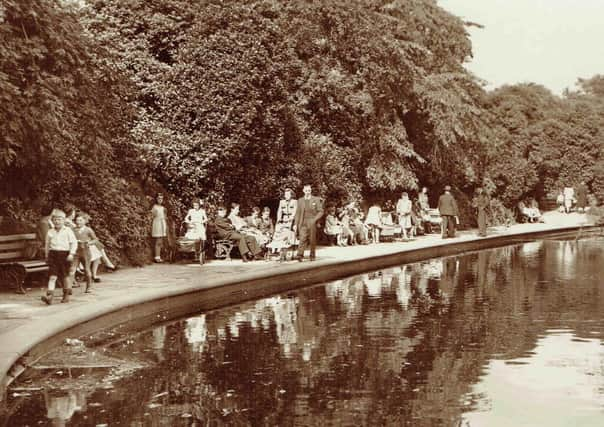The Nostalgia column with Margaret Watson: The provision of parklife


Whether people of my generation will feel confident enough just yet to venture forward we’ll have to wait and see.
Crow Nest Park in Dewsbury is a splendid park, as is Batley Park, both of which were created for the benefit of the working classes.
Advertisement
Hide AdAdvertisement
Hide AdThe provision of parks by local authorities in Victorian times, were regarded as a health necessity as much as a recreational one.


For this reason, Crow Nest Park was built at the top of a hill, far away from smoking mill chimneys and the clatter of industry.
After it was opened in 1893, the park was regularly visited by thousands of people, not only at weekends but also in the evening.
It was regarded by many as a health resort for the working classes, people who could never afford holidays away from home.
Advertisement
Hide AdAdvertisement
Hide AdThe park became the pride of Dewsbury Council which employed scores of gardeners and labourers to keep it looking spick and span.
Brass bands played at weekends, and while the adults enjoyed dancing in front of the bandstand, the children splashed happily in the paddling pool.
It was a place for families, a place where children could play in safety, somewhere which Dewsbury people knew belonged to them.
There was no admission charge and it was open seven days a week from dawn to dusk.
Advertisement
Hide AdAdvertisement
Hide AdYes, this green and pleasant parkland, once a secluded and private estate owned by just one family, now belonged to everyone.
Previously, it had been closed to public view, and the only people allowed through its gates without invitation, were the labourers working on the land.
It was known as the Crow Nest Estate and stretched over 70 acres, and those living there resided in a large house known as Crow Nest Hall.
This later became a museum and park cafe, both now sadly closed because of local government cuts.
Advertisement
Hide AdAdvertisement
Hide AdThe last people to live there was the Hague family, who in 1893 agreed to sell it to Dewsbury Corporation for £20,000.
The council spent a further £12,000 laying it out, and the cost of maintaining it was £1,200 a year.
The park today, however, is smaller than it was then, due to the council using parts of it on which to build council houses and the crematorium.
The park lake also changed over the years.
Once it was two lakelets separated by a footbridge which visitors could walk across to reach the island.
Advertisement
Hide AdAdvertisement
Hide AdThere was also a cascading fountain at one end rising 12 feet into the air, the workings for which are still there.
Perhaps one day someone might get them going again.
In the early days, the park also attracted many aquatic birds which made their home on the island.
The lake was also lined by rockeries adorned with all manner of shrubs and flowers, including silver and golden holly bushes, ivies, rhododendrons, honeysuckles, iris, yuccas, and many more.
Dewsbury council also planted some London plane trees which were able to digest industrial smoke, of which there was plenty in Dewsbury at that time.
Advertisement
Hide AdAdvertisement
Hide AdThousands attended the opening of the park on that beautiful sunny Saturday lunchtime in September 1893.
How strange to see working class people strolling through grounds which had once been the domain of the privileged few.
The origin of the name Crow Nest and its early history seem to be lost, but it is believed a house and estate belonging to the Bedford family existed there as early as 1571.
In 1798 it came into the hands of the Hague family, at a time when Dewsbury was a relatively small town with a population of only 4,500, most of whom were engaged in the woollen cloth-making trades.
Advertisement
Hide AdAdvertisement
Hide AdBy the beginning of the 19th century, Dewsbury had already established a reputation for the making of high quality blankets, and over the years it fast became a prosperous textile town.
Throughout this period of growth, the Hague family lived in Crow Nest Hall and leased out much of their 70-acre estate to neighbouring farmers.
In 1811, John Hague decided to branch out into textiles and bought a mill in Dewsbury for £33,750 which eventually became Wormald and Walker’s in Thornhill Lees.
John Hague Jnr was a Justice of the Peace for more than 30 years, a deputy-lieutenant of the West Riding and also a trustee of the Daw Green Charity School.
Advertisement
Hide AdAdvertisement
Hide AdAfter his death, the estate passed to his widow and then to a relative, Mr Thomas Hague Cook, who died in 1877.
He was succeeded by his son, Thomas Reginald Cook, who sold the property to Dewsbury Corporation.
Dewsbury people had never seen such rejoicing as they did on the day Crow Nest Park was officially opened.
It was estimated that between 30,000 to 40,000 people visited the park that day, and later in the afternoon 6,000 schoolchildren made their way to the park after enjoying a treat at their respective schools.
○ Email [email protected] with your bygone memories of the Dewsbury area.